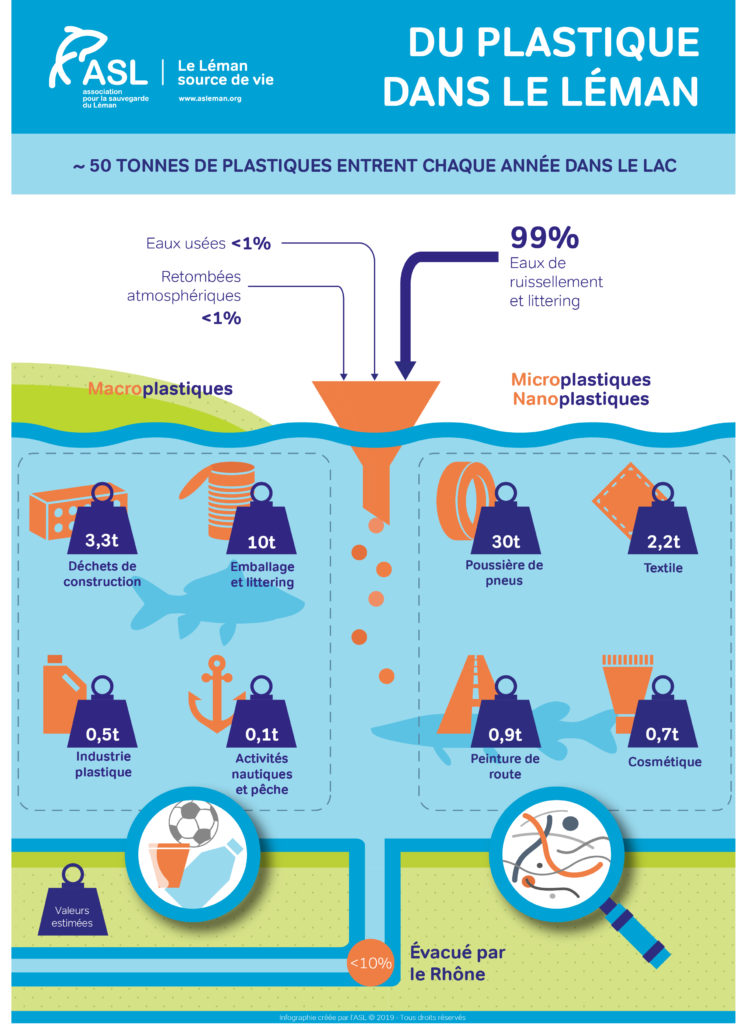
Microplastics
Microplastics are small particles of plastic, not more than 5mm, which have been dispersed in the environment.
Key figures
What are microplastics?
The pollution of water by microplastics (less than or equal to 5 millimeters) is universally recognised as one of the most dangerous threats to the world’s waters. Lake Geneva is no exception to this phenomenon, and the presence of a variety of types of plastics has been confirmed by a number of studies carried out by the GR-CEL laboratory at EPFL, among others.
Currently, the most obvious effect is the threat to the lake’s wildlife. Birds, fish and mammals are the first victims of microplastics, which can cause obstruction of the digestive or respiratory tract when they are eaten. In the worst cases, this is fatal.
Another less visible but equally problematic consequence of microplastic pollution is their ingestion by smaller organisms, such as plankton, mussels, etc. According to an EPFL report commissioned by the Federal Office for the Environment (FOEN), this is certainly taking place. The impact on the food chain through the phenomenon of bioaccumulation has not yet been proved, although it is considered highly likely to be occurring. Bioaccumulation means that additives present in certain plastics would be metabolised and passed on as toxic components when small organisms are eaten by larger creatures higher up the food chain. In other words, humans located at the top of the food chain could absorb very large quantities of harmful products by eating fish, molluscs, etc caught in the lake. This would follow the same process as the bioaccumulation of various heavy metals which is already an acknowledged phenomenon.
Lake Geneva is not exempt from this type of pollution. In order to learn more, the ASL commissioned a specialist in this field, Dr Julien Boucher, to model the flow of plastics in Lake Geneva. The results were compared with data from the field, and the full study was published as an article in Trends in Analytical Chemistry, a well-known scientific journal, in 2018. The study also appeared as an article in issue 110 of our journal Lémaniques.
Sources of plastic pollution in Lake Geneva:
- Overflow from storm draina
- Rainwater runoff
- Urban and rural area
- Dumping of rubbish
- Waste water
- Airborne deposits
According to the results, 99% of the plastic in Lake Geneva enters via runoff! It should also be noted that only 10% of the plastic poured into the lake is flushed out by the Rhône. Lake Geneva therefore acts as a settling basin.
The model applied in the study takes into account social and economic conditions and other local specificities. It is based on the life-cycle of plastic products which includes three main phases: the production and transformation of plastic in situ, its use, and its disposal.
In each phase, leakages can take place and can contaminate the natural environment.
The total average quantity of waste is estimated at around 50 tonnes per year, 60% of which comes from tyres and 20% from littering.
Following these results, on November 21 2019 the ASL organized a high-level workshop on microplastics, inviting scientists, infrastructure managers and officials to discuss the issues. The workshop had two main aims – firstly, to produce an informed assessment of the state of affairs in our region, and secondly to come up with feasible solutions for practical projects.
Click on the link below to see a video of the day’s events.
These groups of experts focussed on four topics selected by the ASL:
- Plastic pollution via road water: tyre dust
What can be done to reduce the major source of plastic in Lake Geneva?
- Water treatment
Vectors or brakes on plastic pollution in aquatic ecosystems (lakes, rivers)? - Littering
How can we minimize macro-plastics (+ 5mm) in the environment?
- Ecosystems
What are the dangers of plastic pollution and can they affect humans via the food chain?
Following these workshops, a summary report will be published, and in 2021 the results will be presented at an open conference intended to inform the local population of the situation in our region at the present time.


